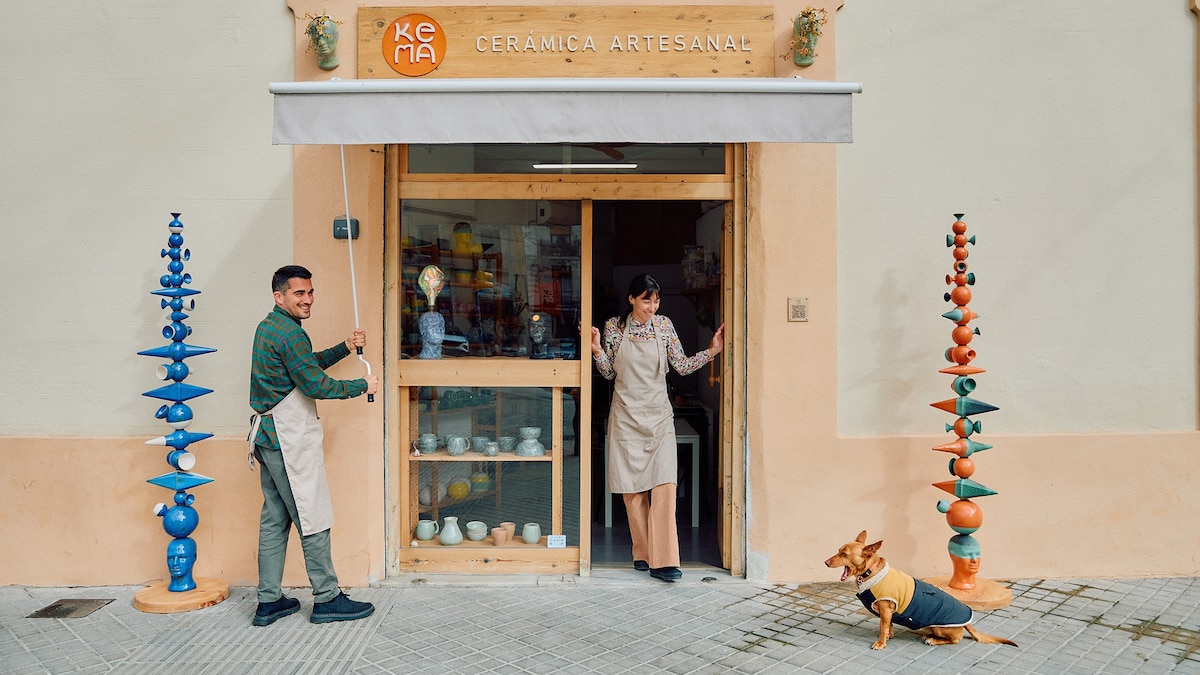Now Reading: Experience the revival of Barcelona’s Poblenou district
-
01
Experience the revival of Barcelona’s Poblenou district
Experience the revival of Barcelona’s Poblenou district

This article was produced by National Geographic Traveller (UK).
In Barcelona’s leafy Poblenou district, Pablo Pulido, an Argentinian ceramicist and jazz musician, points to the sky outside his narrow workshop’s open doorway when I ask why he moved here. “We liked the light principally,’ he tells me, “and the closeness to the sea.” The bright Mediterranean sun floods in through the shop’s large windows, bouncing off the whitewashed walls to illuminate the mauve and yellow bowls and cups that line the shelves.
Despite his beige work apron, 42-year-old Pablo looks as well manicured as a matinee idol. He opened Kema two years ago with his partner Daiana Nuñez Schneider, a Uruguayan ceramicist and industrial designer. Theirs is just one of a new influx of galleries, studios and independent boutiques and coffeeshops that, over the past few years, has garnered Poblenou the moniker ‘the Catalan Hackney’.
Bordered by the sea to the south and one of Barcelona’s major arteries, Avinguda Diagonal, to the north, the area was a powerhouse of the Catalan textile industry in the late 19th and early 20th centuries. By the late 1980s, however, many of Poblenou’s warehouses and factories had been abandoned. Attracted by the large, light-filled studio spaces and relatively low rents, artists soon began moving into the area. Though it’s just 15 minutes north east of Barcelona’s frenetic Las Ramblas by metro, it feels like another world.

Animator Asis Percales in his Poblenou studio, both a home and an office, with vast windows through which the sea can be glimpsed over rooftops.
Photograph by Anna Huix

Poblenou’s mashup of tenants and residents gives the district an atmosphere that locals believe has been lost in some other areas of Barcelona, since the 1990s dawn of mass tourism.
Photograph by Anna Huix
For Pablo and Daiana, the sense of a genuine community was also part of the area’s appeal. “A lot of our neighbours have bought things or come and made their own pieces in our workshop,” says Pablo. “Next door, there’s an iron worker’s forge and a guy who repairs bicycles, so people feel a sense of belonging to the neighbourhood.” Poblenou’s mashup of tenants and residents gives the district an atmosphere that locals believe has been lost in some other areas of Barcelona, since the 1990s dawn of mass tourism.
Neighbourhood bars and stylish restaurants advertise three-course menús del día (menus of the day) for around €15. Students chatter at pavement cafes. And the heart of the neighbourhood is characterised by streets lined with gabled factory and warehouse buildings, ornate art nouveau apartment block doorways and angular steel and glass high-rises, now home to art and design colleges, as well as international firms. Dotted among them are independent shops like Guau!, a small gallery and store selling work by local artists, and tall, 19th-century redbrick chimneys left over from Poblenou’s industrial past.
Just a few blocks from Kema, muralist and illustrator Asis Percales shares an eighth-floor studio with animator Gerard Cornella (aka Geco), who worked on the award-winning animated feature Chico and Rita. Their organised, plant-filled studio — open to the public by appointment — is both a home and an office, with vast windows through which the sea can be glimpsed over rooftops.
The pair say that Poblenou’s relative tranquillity compared to the crowded city centre is part of the area’s appeal. “You’ve got the contrasts between contemporary Barcelona, industrial Barcelona and a real neighbourhood,” says Geco, who wears a neatly manicured beard and crisp white T-shirt.

Describing himself as a ‘painter of daily life’, Perico Pastor has lived and worked in the area for 25 years, creating Matisse-influenced watercolours.
Photograph by Anna Huix
Asis also mentions another instrumental figure in Poblenou’s creative community: Claudia Costa Oropeza, a Venezuelan gallery owner and former film producer. At her bright, white-walled La Plataforma gallery inside a converted printing workshop, I catch her between meetings. “When I came here for the first time, it was clear immediately that this was the area that was going to grow in Barcelona,” she explains, her chestnut hair scraped back into a ballerina-style bun. “Because you’re by the sea and you have a lot of industrial spaces that are perfect for creative and cultural venues. And at that time, a lot of those spaces were empty.”
That was around 2010, and after moving here Claudia soon felt there was a need to galvanise and promote Poblenou’s growing creative community. This set the wheels in motion for her to co-found the Poblenou Urban District in 2012, a cultural association that helps promote the area’s community through events such as open studio days and nights. It also produces a map featuring local arts spaces, galleries, museums, open studios and restaurants.
My final visit is to the studio of one of the artists featured on that map — Perico Pastor, a successful Catalan painter and illustrator for The New York Times and La Vanguardia, Catalonia’s most prestigious broadsheet newspaper. As I arrive at the large converted warehouse, workmen are hauling a wooden pallet into a service lift. Upstairs, many of the units are now home to designers, musicians and artists. Perico’s neighbour is the surrealist painter Matías Krahn, whose studio is also on the map.

“When I first came here, there were still traditional printing works and garment shops. It was a very working-class atmosphere and people were always very friendly… 25 years later, it still has that feel,” says Ppainter and illustrator Perico Pastor in his home studio.
Photograph by Anna Huix
Describing himself as a ‘painter of daily life’, Perico has lived and worked in the area for 25 years, creating Matisse-influenced watercolours, many featuring the beach and seafront promenade.
Despite being in his early seventies, Perico cuts a nimble figure as he shows me around his studio. The walls are lined with bookshelves; calligraphy brushes resting in jam jars on high work tables; and wind chimes hanging in large windows that look out to the sea. The bohemian space is both Perico’s home and studio, and, like his neighbours, he says he still thrives on Poblenou’s authentic atmosphere.
“When I first came here, there were still traditional printing works and garment shops. It was a very working-class atmosphere and people were always very friendly. The wonderful thing is that, 25 years later, it still has that feel. And you’re just three blocks from the beach,” he explains. “There are lots of artists here, but it doesn’t feel like an artists’ colony. There’s a mixture of genders and ages, of kids, cats, dogs, ex-pats and old farts like me, but it’s not rowdy. It’s really cool.”
Published in the June 2025 issue of National Geographic Traveller (UK).
To subscribe to National Geographic Traveller (UK) magazine click here. (Available in select countries only).























